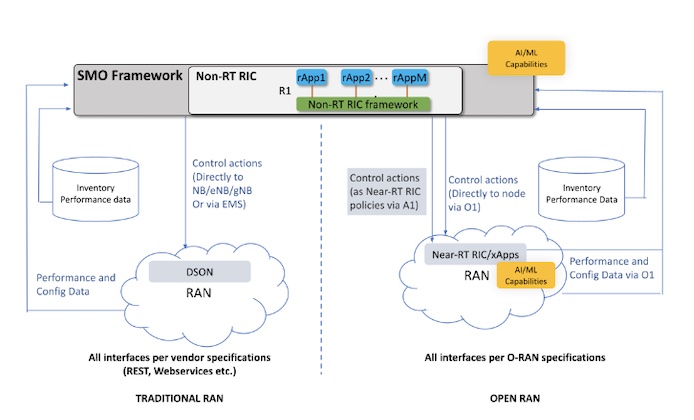ONF’s SMaRT-5G Project is focused on developing, demonstrating and open sourcing ML (Machine Learning) - driven, intelligent energy savings solutions for mobile networks. Initial collaborators include Intel, META/TIP, Rimedo Labs, and Rutgers WINLAB and we invite more participants to join this exciting community effort.
Worldwide mobile network energy costs are conservatively estimated at more than $25B annually, with 70-90% of these costs attributed to the RAN ($17.5B - $22.5B). Assuming 8% savings were to be achieved as a result of the SMaRT-5G project, annual savings would conservatively translate to $1.4B - 1.8B. But perhaps more importantly, operators are under significant pressure to reduce their carbon footprint which accounts for 2 - 3% of total global energy consumption. It is imperative that MNOs significantly improve their energy efficiency, and SMaRT-5G is designed specifically to help operators and vendors make significant and rapid strides towards a net zero carbon footprint for mobile networks.
The ONF SMaRT-5G initiative will build a series of Proof of Concept (PoC) implementations to demonstrate progressively advanced energy savings techniques on both open source RAN stacks as well as commercial-grade RAN configurations. Structured as a phased series of PoCs designed to enable MNOs to start using the results from each PoC on both new disaggregated open RAN solutions as well as with and traditional RAN architectures, the SMaRT-5G project will thus be able to provide the fastest possible industry impact.
To learn more about this important new project being kicked off, check out the SMaRT-5G Project White Paper. To explore joining this exciting community; complete this form and someone on the project leadership team will get in touch.
Energy Saving Approaches
The O-RAN RIC-based architecture is highly suitable to implement RAN energy saving solutions (you can learn more on this in the SMaRT-5G Project White Paper). The PoCs planned for SMaRT-5G are designed to be easily leveraged by operators to help accelerate adoption of O-RAN standards and energy savings solutions.
The first PoC of the SMaRT-5G project will focus on demonstrating traffic optimized cell on/off capabilities. Additionally, MIMO Sleep and RF Channel Switch On/Off based on traffic will then be implemented and demonstrated. Going beyond what RAN vendors have implemented in the form of Distributed Self Organizing Network (DSON) for traditional RAN, the SMaRT-5G project plans to provide advanced capabilities that can only be implemented given a holistic view of the RAN in a geographical area, such as load-based cell sleep/wake up decisions, intelligent automatic configuration of cell sleep / wake up thresholds, closed control-loop implementations that self-optimized based on user experience, and more.

RAN energy saving using O-RAN Architecture to support both traditional and open RAN
In subsequent PoC phases, Advanced Sleep Mode (ASM) capabilities will be leveraged and demonstrated. Plans are also to consider energy saving approaches for Core as well as for compute infrastructures supporting both RAN and Core.
Learn More and Join the Community
- Stay up-to-date on news and events related to the SMaRT-5G project by joining the mailing list.
- Explore joining the growing SMaRT-5G community; complete this form and project leadership will be in touch.
- Additional Resources:

